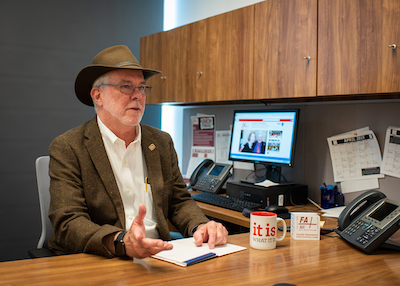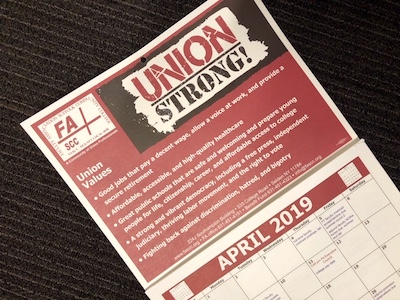Susan Rubenstein DeMasi
My earliest memories of Kevin Peterman, our retiring union president, come from my first few years at SCCC, when I was media librarian at the Ammerman Campus. We met monthly with colleagues Jay Schwartz, John Longo and Kevin McCoy, usually in the library basement’s Harry Potter room—aptly but unofficially named because of its location under the stairs. We’d typically finish our media library business and then let our conversations veer into politics for a few minutes before going our separate ways. Except we did. I don’t mean secret union information or gossip. I mean that all of us, members of the Faculty Association, were on the receiving end of the efforts he had been putting in since the mid-1980s when he first became a librarian at the Eastern Campus. Most people don’t know that Kevin started at SCCC in 1977 as an audiovisual technician at the very young Michael J. Grant Campus. In that position, he was a member of the AME bargaining unit. Within a few years, he became a professional assistant in media central and joined the FA, all the while going to library school at night. When he finished his degree, he applied and was accepted for the librarian position at the Eastern Campus. (He later finished his M.A. in Communications Arts.) “I became involved with the union then. They were looking for a rep from the Eastern Campus. I had some experience in public relations and I volunteered to help out. I was interested in photography so I did a lot of that for the union. So I just stepped in. I hit it off with Ellen; we worked well together.” Early on, he understood the importance of political involvement to making the union work. “I knew that the union was going to be the vehicle to make us more successful. And like it or not, there is a political element to this organization because of the nature of the beast, the way we get our funding.” His early involvement—“when we didn’t have a contract and were going through some tough negotiations”—came as part of the gnat squad. That meant, essentially, showing up at political functions and following the county executive around. “When he would go to events at night, we’d go also, just to be there. He’d see me and he couldn't not think about the fact that we were working without a contract.” Soon after he moved to the Michael J. Grant Campus library in 1985 (then located in the Caumsett Hall basement), Kevin was voted in as FA secretary, a position he retained until his 1991 election to Executive Vice President. With a growing college came a growing and more influential union. The FA’s increasing alliance and ensuing activism with the state union, NYSUT, its coalitions with other labor groups (local, state and national) and its networking with lawmakers all became central to that. And it wasn't just about ensuring better working conditions and salaries for union members. “I realized it’s another way to help students. You’re trying to get a good contract, but you are also trying to make the college better for everyone, which includes the students.” “Like it or not, you have to be at the [political] table. I’m glad many people realize that VOTE/COPE is a good vehicle for that. Whether you like the system or not, that’s the system. We can sit back and say we don't want to deal with that, but I don't think we would be where we are if we didn't get involved the way we did.” He’s proud of many undertakings, including the fact that the current NYSUT president has called the FA a “model for getting things done.” Kevin’s philosophy is that “you try to work with management to get mutual gains, saying, ‘we have this issue, how can we solve it?’ And most of the time we try and do that. But sometimes you have to butt heads.” Kevin remains especially proud of the coalition building that helped get capital projects funded over the years. “In order to do these things, you have to have the funding. People don't realize how long it takes to get anything done. The fact that we get funding from the state and the county, we were able to say to the county, you only need to spend half the money for the library because the state is going to pay the other half.” He involved the building trades (he’s on the Long Island Federation of Labor board) and other unions as well. “We were able to say, we need the buildings and you guys get the work. It strengthened our requests. And whether it was the new library here, or the Lindsay building on Ammerman, or the Health and Wellness Center out east, I felt that the students deserved it. Originally, Grant was just Pilgrim State buildings. When this library, the Grant Campus LRC, opened, I walked around and said to the students, ‘this is your building, you deserve it.’ Because they do.” “You need outreach. Networking and coalition building are key.” Students are central to the union’s goals. When union members go to Albany to discuss funding with legislators, they bring students with them. “That's helpful,” Kevin says, “because the students tell their stories. For the last 20 years, higher education nationally has been underfunded. I believe if we don’t go to Albany, we’re not going to get anything.” He adds that with the political landscape these days being, “a little scary, I think we need to build more coalitions. We need to get more students involved.” Of his retirement, Kevin says it was a tough decision “because I really like what I’m doing. But after 42 years, what’s the point of working if I work so much that when I retire I can’t do anything? I want to travel, I want to take pictures, I want to get back into my photography.” But that doesn't mean Kevin won’t stay involved. He’s interested in working on issues surrounding the 2020 census and the communities, such as immigrants, that may be undercounted. “There are groups that are afraid, especially in our local community. So many people are afraid that they won’t be counted and I think that’s something that needs attention.” He remains dedicated to unions and may become involved in NYSUT’s retiree council. “If it weren’t for unions, I don't believe there would be a middle class. The attacks on unions, with the Janus decision and related occurrences, show that there are groups that want to destroy labor groups. If that happens, we are really in trouble.” He added that “one of the things that concerns a lot of union leaders is that some, not all, of the newer union members don't understand how we got where we are. When I tell people that 25 years ago we had a strike headquarters or that we picketed the Dennison Building, they seem incredulous. But those are the things we had to do.” His advice for those in the next generation of union leaders: “Be yourself and you’ll find your niche or comfort zone.” His advice for newer FA members: “Get involved. Volunteer when we have an event. Come to Albany with us. Attend the NYSUT Community College Conference. Show up. People have to get involved. If they don't, I’m fearful of what could happen.” In these last months of his presidency, he says the union team is focusing on the contract. “I would like to get that while I’m president. We picked a really good negotiating team and one way or the other we will have a contract. If we can negotiate something, that would be great. But if not, because of our past union advocacy, there is a law in effect called Triborough which keeps the current contract in effect until we negotiate a new one. In September, even if we don't have a contract, the people who are eligible for steps will get their steps. If we didn't have a union, that wouldn't happen.”
He adamantly espouses union values for all. “There are sometimes people out in the public who resent the fact that we have protections because they don’t. And their philosophy should be, ‘they have it and so should we.’ Everyone should have healthcare. Everyone should have a pension.” If you are wondering what those values are, look at your FA calendar, given out to every member. They include “good jobs that pay a decent wage, allow a voice at work, and provide a secure retirement; great public schools that are safe and welcoming; a strong and vibrant democracy, including a free press, independent judiciary, thriving labor movement, and the right to vote.” And so much more. “We need to have this on everyone’s wall. When you put that calendar on the wall, make sure you look at what we’re talking about,” Kevin says. Back to the Harry Potter room. There was not much magic being made during our meetings when we took care of our important, but routine library business. The magic came after. |

